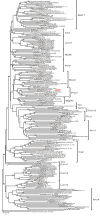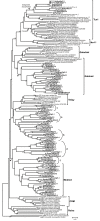Evolutionary genomics revealed interkingdom distribution of Tcn1-like chromodomain-containing Gypsy LTR retrotransposons among fungi and plants
- PMID: 20377908
- PMCID: PMC2864245
- DOI: 10.1186/1471-2164-11-231
Evolutionary genomics revealed interkingdom distribution of Tcn1-like chromodomain-containing Gypsy LTR retrotransposons among fungi and plants
Abstract
Background: Chromodomain-containing Gypsy LTR retrotransposons or chromoviruses are widely distributed among eukaryotes and have been found in plants, fungi and vertebrates. The previous comprehensive survey of chromoviruses from mosses (Bryophyta) suggested that genomes of non-seed plants contain the clade which is closely related to the retrotransposons from fungi. The origin, distribution and evolutionary history of this clade remained unclear mainly due to the absence of information concerning the diversity and distribution of LTR retrotransposons in other groups of non-seed plants as well as in fungal genomes.
Results: In present study we preformed in silico analysis of chromodomain-containing LTR retrotransposons in 25 diverse fungi and a number of plant species including spikemoss Selaginella moellendorffii (Lycopodiophyta) coupled with an experimental survey of chromodomain-containing Gypsy LTR retrotransposons from diverse non-seed vascular plants (lycophytes, ferns, and horsetails). Our mining of Gypsy LTR retrotransposons in genomic sequences allowed identification of numerous families which have not been described previously in fungi. Two new well-supported clades, Galahad and Mordred, as well as several other previously unknown lineages of chromodomain-containing Gypsy LTR retrotransposons were described based on the results of PCR-mediated survey of LTR retrotransposon fragments from ferns, horsetails and lycophytes. It appeared that one of the clades, namely Tcn1 clade, was present in basidiomycetes and non-seed plants including mosses (Bryophyta) and lycophytes (genus Selaginella).
Conclusions: The interkingdom distribution is not typical for chromodomain-containing LTR retrotransposons clades which are usually very specific for a particular taxonomic group. Tcn1-like LTR retrotransposons from fungi and non-seed plants demonstrated high similarity to each other which can be explained by strong selective constraints and the 'retained' genes theory or by horizontal transmission.
Figures





References
-
- Marin I, Llorens C. Ty3/Gypsy retrotransposons: description of new Arabidopsis thaliana elements and evolutionary perspectives derived from comparative genomic data. Mol Biol Evol. 2000;17:1040–1049. - PubMed
Publication types
MeSH terms
Substances
LinkOut - more resources
Full Text Sources
Medical

